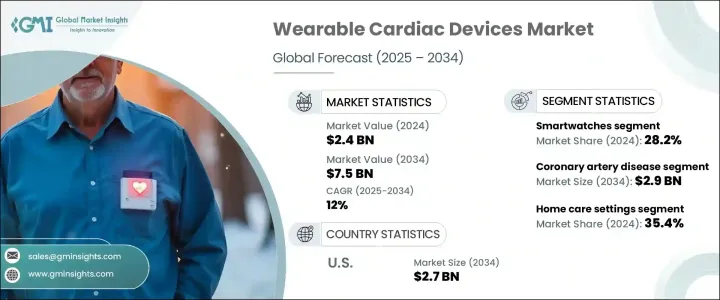PUBLISHER: Global Market Insights Inc. | PRODUCT CODE: 1699260

PUBLISHER: Global Market Insights Inc. | PRODUCT CODE: 1699260
Wearable Cardiac Devices Market Opportunity, Growth Drivers, Industry Trend Analysis, and Forecast 2025-2034
The Global Wearable Cardiac Devices Market was valued at USD 2.4 billion in 2024 and is expected to expand at a CAGR of 12% from 2025 to 2034. These portable medical devices allow individuals to monitor their heart health daily, collecting and analyzing long-term data based on heart rate, rhythm, physical activity, and sleep patterns. By enabling remote monitoring, they eliminate the need for frequent clinical visits, improving patient convenience and medical efficiency. Equipped with advanced sensors and AI-powered analytics, these devices provide real-time insights, helping healthcare professionals make informed decisions. Growing awareness about preventive healthcare, rising cases of cardiovascular diseases, and increasing demand for remote patient monitoring are driving market growth. Wearable cardiac devices are widely used for cardiac arrhythmia monitoring and managing conditions such as heart failure and peripheral artery disease.

The market is segmented by product into smartwatches, Holter monitors, patches, pulse oximeters, defibrillators, and other wearable devices. Smartwatches led the segment, capturing 28.2% of total revenue in 2024. Their user-friendly design allows seamless heart health tracking without professional assistance, making them accessible to a broad audience. AI-powered algorithms help detect irregular heart rhythms and provide real-time health insights. As these watches monitor various vitals, including ECG, heart rate, and oxygen levels, they offer a comprehensive view of cardiovascular health.
| Market Scope | |
|---|---|
| Start Year | 2024 |
| Forecast Year | 2025-2034 |
| Start Value | $2.4 Billion |
| Forecast Value | $7.5 Billion |
| CAGR | 12% |
By application, the market is divided into coronary artery disease, cardiomyopathies, post-myocardial infarction, congenital heart diseases, post-surgical cardiac care, and other related conditions. The coronary artery disease segment held a 37.4% market share in 2024 and is projected to reach USD 2.9 billion by 2034. A surge in lifestyle-related risk factors such as physical inactivity, obesity, and smoking is fueling the demand for wearable cardiac devices in this segment. With rising cases of coronary artery disease, healthcare providers are increasingly relying on wearable technology for early detection and disease management.
The market is further categorized by end use into hospitals, specialty centers, home care settings, and other facilities. Home care settings accounted for a 35.4% share in 2024, reflecting a growing preference for continuous heart monitoring in comfortable environments. These devices enable individuals to track their cardiovascular health at home, reducing dependency on healthcare facilities. Regulatory compliance ensures the effectiveness of wearable devices in point-of-care settings, further driving adoption in this segment.
Regionally, the U.S. wearable cardiac devices market is anticipated to reach USD 2.7 billion by 2034, fueled by a high prevalence of cardiovascular diseases and a well-developed healthcare system. Increasing consumer awareness and technological advancements in wearable health devices are further strengthening market growth.
Table of Contents
Chapter 1 Methodology and Scope
- 1.1 Market scope and definitions
- 1.2 Research design
- 1.2.1 Research approach
- 1.2.2 Data collection methods
- 1.3 Base estimates and calculations
- 1.3.1 Base year calculation
- 1.3.2 Key trends for market estimation
- 1.4 Forecast model
- 1.5 Primary research and validation
- 1.5.1 Primary sources
- 1.5.2 Data mining sources
Chapter 2 Executive Summary
- 2.1 Industry 3600 synopsis
Chapter 3 Industry Insights
- 3.1 Industry ecosystem analysis
- 3.2 Industry impact forces
- 3.2.1 Growth drivers
- 3.2.1.1 Increasing number of patients suffering from cardiovascular diseases
- 3.2.1.2 Rapid technological advancements in wearable cardiac devices
- 3.2.1.3 Growing preference of minimally invasive devices
- 3.2.1.4 Rising health consciousness and preventive care
- 3.2.2 Industry pitfalls and challenges
- 3.2.2.1 Data privacy issues
- 3.2.2.2 Stringent regulatory policies
- 3.2.1 Growth drivers
- 3.3 Growth potential analysis
- 3.4 Regulatory landscape
- 3.5 Technological landscape
- 3.6 Future market trends
- 3.7 Porter's analysis
- 3.8 PESTEL analysis
Chapter 4 Competitive Landscape, 2024
- 4.1 Introduction
- 4.2 Company market share analysis
- 4.3 Company matrix analysis
- 4.4 Competitive analysis of major market players
- 4.5 Competitive positioning matrix
- 4.6 Strategy dashboard
Chapter 5 Market Estimates and Forecast, By Product, 2021 – 2034 ($ Mn)
- 5.1 Key trends
- 5.2 Holter monitors
- 5.3 Smartwatches
- 5.4 Patch
- 5.5 Defibrillators
- 5.6 Pulse oximeters
- 5.7 Other products
Chapter 6 Market Estimates and Forecast, By Application, 2021 – 2034 ($ Mn)
- 6.1 Key trends
- 6.2 Coronary artery disease (CAD)
- 6.3 Cardiomyopathies
- 6.4 Post-myocardial infarction
- 6.5 Congenital heart diseases
- 6.6 Post-surgical cardiac care
- 6.7 Other applications
Chapter 7 Market Estimates and Forecast, By End Use, 2021 – 2034 ($ Mn)
- 7.1 Key trends
- 7.2 Hospitals
- 7.3 Specialty centers
- 7.4 Home care settings
- 7.5 Other end use
Chapter 8 Market Estimates and Forecast, By Region, 2021 – 2034 ($ Mn)
- 8.1 Key trends
- 8.2 North America
- 8.2.1 U.S.
- 8.2.2 Canada
- 8.3 Europe
- 8.3.1 Germany
- 8.3.2 UK
- 8.3.3 France
- 8.3.4 Spain
- 8.3.5 Italy
- 8.3.6 Netherlands
- 8.4 Asia Pacific
- 8.4.1 China
- 8.4.2 Japan
- 8.4.3 India
- 8.4.4 Australia
- 8.4.5 South Korea
- 8.5 Latin America
- 8.5.1 Brazil
- 8.5.2 Mexico
- 8.5.3 Argentina
- 8.6 Middle East and Africa
- 8.6.1 South Africa
- 8.6.2 Saudi Arabia
- 8.6.3 UAE
Chapter 9 Company Profiles
- 9.1 Abbott Laboratories
- 9.2 Boston Scientific
- 9.3 Cardiac Insight
- 9.4 CardiacSense
- 9.5 Cardiac Rhythm
- 9.6 iRhythm Technologies
- 9.7 Integra LifeSciences
- 9.8 Koninklijke Philips
- 9.9 Medtronic
- 9.10 Proteus Digital Health
- 9.11 Qardio
- 9.12 ZOLL Medical Corporation
- 9.13 Welch Allyn
- 9.14 VitalConnect
- 9.15 Zimmer Biomet




